The Northern Jewel Box Cluster is a bright open cluster located approximately 5,600 light-years away in the constellation Scorpius. With an apparent magnitude of 2.6 and an apparent size of 15 arcminutes, the star cluster is easily observed in binoculars and small telescopes. It is listed as NGC 6231 in the New General Catalogue and Caldwell 76 in the Caldwell catalogue of objects that can be seen in amateur telescopes.
NGC 6231 has an estimated age of only 2 – 7 million years. The cluster’s stars are members of the young Scorpius OB1 association. Sco OB1 is a grouping of hot, massive stars that formed in the same stellar nursery at around the same time and share a common motion through space.
The hot blue hypergiant Zeta1 Scorpii, faintly visible to the unaided eye, is the brightest member of the association. The supernova candidate has a mass 36 – 53 times that of the Sun and lies approximately 6,000 light-years away. Its visual companion, the brighter Zeta2 Scorpii, is an orange giant located only 135 light-years away. It is not related to the group.
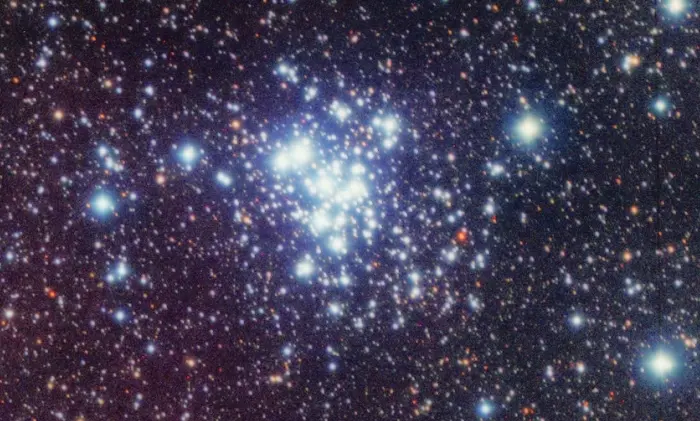
Northern Jewel Box Cluster – NGC 6231 (cropped from larger image), credit: Ivan Bok (CC BY 4.0)
The Northern Jewel Box and the Scorpius OB1 group both lie in the Sagittarius Arm of the Milky Way. The cluster appears at the centre of the stellar association.
The cluster was nicknamed the Northern Jewel Box because of its resemblance to the brighter Jewel Box Cluster (NGC 4755) in the southern constellation Crux. Also known as the Kappa Crucis Cluster, NGC 4755 appears in the region of the Southern Cross , near Mimosa (Beta Crucis), and stays below the horizon for observers in the mid-northern latitudes. Unlike its southern counterpart, the Northern Jewel Box may be spotted above the southern horizon from locations as far north as latitude 47-48°.
The cluster is sometimes also called the Table of Scorpius Cluster, the Baby Scorpion Cluster, the Crocodile Cluster, or the False Comet Nebula. It is catalogued as Collinder 315 (CR 315) and Melotte 153 (Mel 153).
The Northern Jewel Box Cluster marks the head of the False Comet, a visual grouping of stars and deep sky objects that resembles a comet. The asterism lies in the region between the pairs Zeta1 and Zeta2 Scorpii and Mu1 and Mu2 Scorpii. The bright Prawn Nebula (IC 4628) forms a portion of the comet’s tail and the open cluster NGC 6242 marks the end of the tail. The asterism is also formed by Zeta Scorpii, the open clusters Collinder 316, and Trumpler 24. It was named the False Comet by the English astronomer John Herschel in the 1830s, when he studied the southern sky from South Africa.
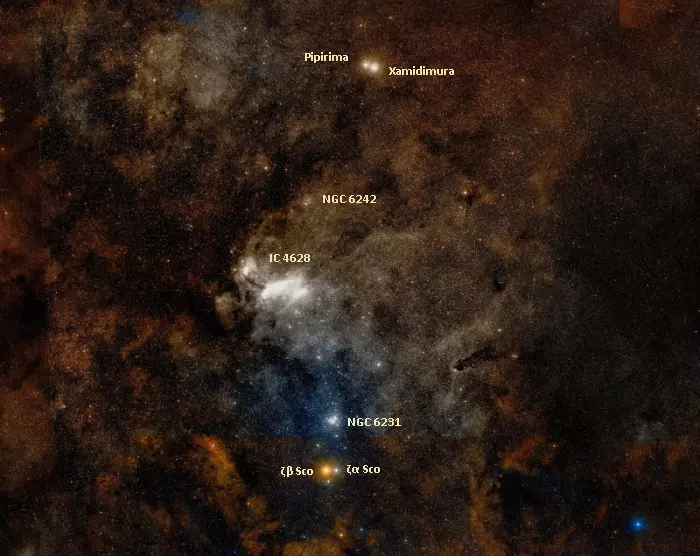
The False Comet, image: Wikisky (DSS2)
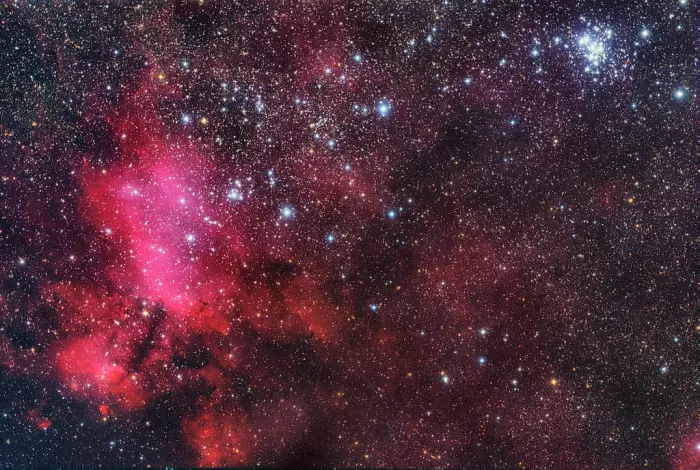
The Prawn Nebula (IC 4628) is an emission nebula and star-forming region located in the constellation of Scorpius. Due to the presence of hydrogen-rich gas clouds, it glows in a reddish hue when high energy radiation from massive stars ionize the interstellar gas cloud. Beside the Prawn Nebula is a bright star cluster known as the Northern Jewel Box or False Comet. Designated as NGC 6231, it appears to leave a trail of stars leading to IC 4628. Image credit: Ivan Bok (CC BY 4.0)
Facts
NGC 6231 was discovered by the Italian astronomer Giovanni Battista Hodierna before 1654. However, Hodierna was historically not credited for the discovery, even though he listed the cluster’s stars as Luminosae in his catalogue. The catalogue was published as part of his book De Admirandis Coeli Characteribuse in 1654.
The Northern Jewel Box was independently discovered by the English astronomer Edmond Halley in 1678, the Swiss astronomer Jean-Philippe Loys de Cheseaux in 1745-46, and the French astronomer Nicolas-Louis de Lacaille in 1751-52.
NGC 6231 is approaching the solar system at 22 km/s.
The cluster contains three known Wolf-Rayet stars: WR 78 (HD 151932), WR 79 (HD 152270), and WR 79a (HD 152408). WR 78 appears about 22’ west of the cluster and its membership is uncertain. It shines at magnitude 6.5 and is theoretically visible to the unaided eye. WR 79a has an apparent magnitude of 5.77 and is one of the brightest Wolf-Rayet stars in the sky. It lies in the northern portion of the cluster, but may not be a member.
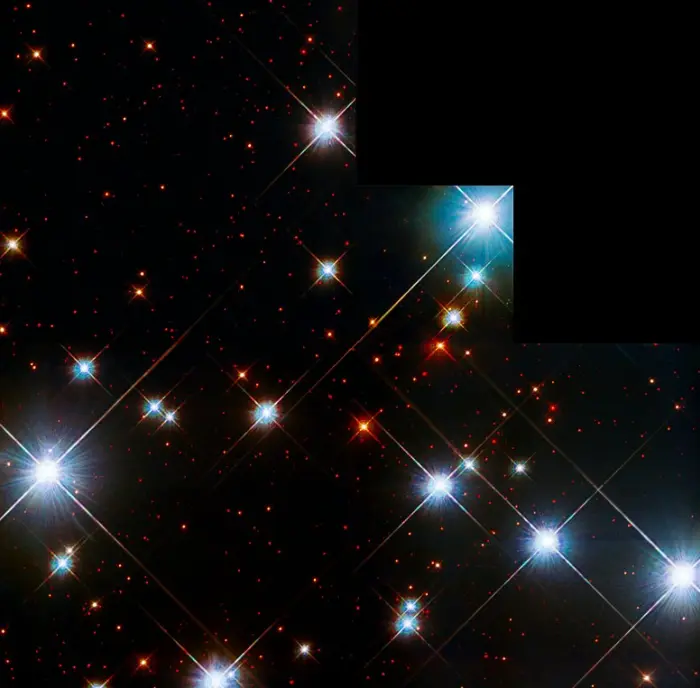
This image captures the shining stars in a portion of the open cluster Caldwell 76, also known as NGC 6231. It combines observations taken at ultraviolet, visible, and infrared wavelengths by Hubble’s Wide Field and Planetary Camera 2. By probing open clusters in the far-ultraviolet, astronomers were able to more efficiently find white dwarfs (the cores of stars that have shed their gaseous shell) that would be difficult to detect in the cluster using other methods. This was the first far-ultraviolet survey of open clusters in the Milky Way performed at such high resolution. First discovered by the Italian astronomer Giovanni Battista Hodierna, it has an apparent magnitude of 2.6 and can be spotted with the unaided eye when the skies are dark and clear. The cluster appears as a fuzzy patch of light to the unaided eye, but its individual stars can be resolved using a pair of binoculars. Image credit: NASA, ESA, and J. Maiz Apellaniz (Centro de Astrobiologia [CSIC/INTA]); Processing: Gladys Kober (NASA/Catholic University of America) (CC BY 2.0)
Location
The Northern Jewel Box lies in the region of the Fish Hook, a prominent asterism that makes the constellation Scorpius easily recognizable. The cluster is found only half a degree north of Zeta Scorpii.
At declination -41° 48’, the cluster stays close to the southern horizon for observers in the northern hemisphere. It is best seen from the equatorial latitudes and the southern hemisphere, where it rises higher in the sky.
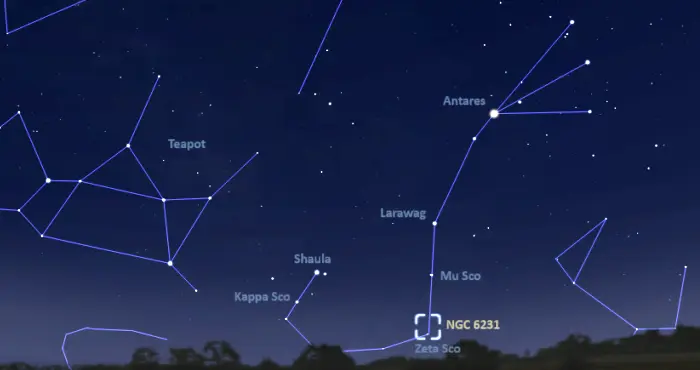
The location of the Northern Jewel Box Cluster, image: Stellarium
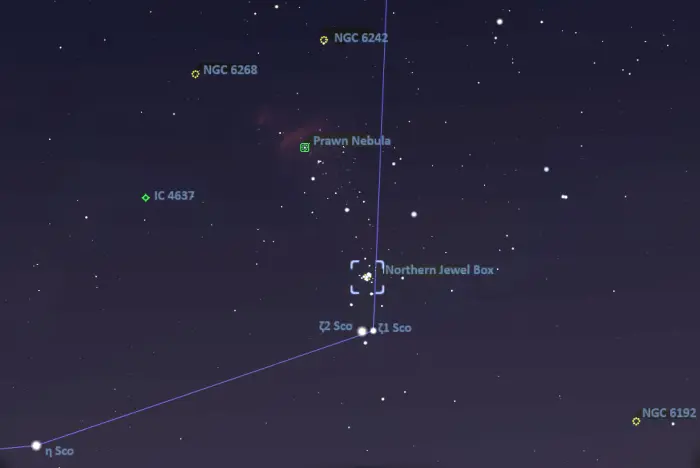
NGC 6231 location, image: Stellarium
On a clear night, NGC 6231 is visible to the unaided eye. A 4-inch telescope will reveal more than 100 individual members of the cluster.
The best time of the year to observe the Northern Jewel Box and other deep sky objects in Scorpius is during the month of July, when the constellation appears higher above the horizon in the early evening.
Northern Jewel Box Cluster – NGC 6231
| Constellation | Scorpius |
| Object type | Open cluster |
| Right ascension | 16h 54m10.8s |
| Declination | −41° 48′ 43’’ |
| Apparent magnitude | 2.6 |
| Apparent size | 15.0′ |
| Distance | 5,600 ± 400 light-years (1,700 ± 130 parsecs) |
| Age | 2 – 7 million years |
| Names and designations | Northern Jewel Box Cluster, NGC 6231, Collinder 315, Caldwell 76, Melotte 153, Dunlop 499, De Cheseaux 9, Lacaille II.13, Ha. I.7 |
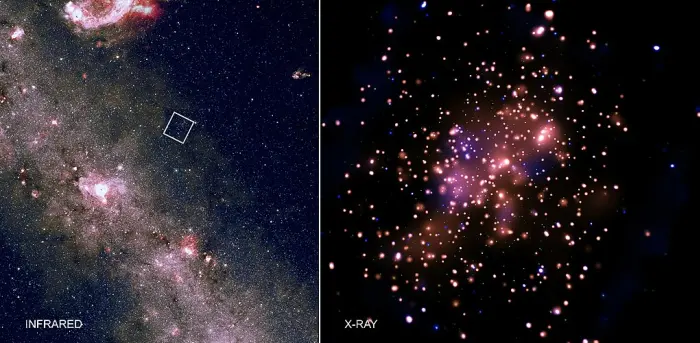
NASA’s Chandra X-ray Observatory has been used to identify the young Sun-like stars in NGC 6231, which have, until recently, been hiding in plain sight. Young star clusters like NGC 6231 are found in the band of the Milky Way on the sky. As a result, interloping stars lying in front of or behind NGC 6231 greatly outnumber the stars in the cluster. These stars will generally be much older than those in NGC 6231, so members of the cluster can be identified by selecting signs of stellar youth. Young stars stand out to Chandra because they have strong magnetic activity that heats their outer atmosphere to tens of millions of degrees Celsius and causes them to emit X-rays. Infrared measurements assist in verifying that an X-ray source is a young star and in inferring the star’s properties. This Chandra X-ray image of NGC 6231 shows a close-up of the inner region of the cluster. Chandra can detect a range of X-ray light, which has been split into three bands to create this image. Red, green, and blue represents the lower, medium, and high-energy X-rays. The brightest X-ray emission is white. The Chandra data, combined with infrared data from the Visible and Infrared Survey Telescope for Astronomy (VISTA) Variables in the Vía Lactéa survey has provided the best census of young stars in NGC 6231 available. An infrared image from NASA’s Wide-field Infrared Survey explorer is shown on the left. There are an estimated 5,700 to 7,500 young stars in NGC 6231 in the Chandra field of view, about twice the number of stars in the well-known Orion star cluster. The stars in NGC 6231 are slightly older (3.2 million years on average) than those in Orion (2.5 million years old). However, NGC 6231 is much larger in volume and therefore the number density of its stars, that is, their proximity to one another, is much lower, by a factor of about 30. These differences enable scientists to study the diversity of properties for star clusters during the first few million years of their life. Image credit – X-ray: NASA/CXC/Univ. of Valparaiso/M. Kuhn et al; IR: NASA/JPL/WISE (PD)
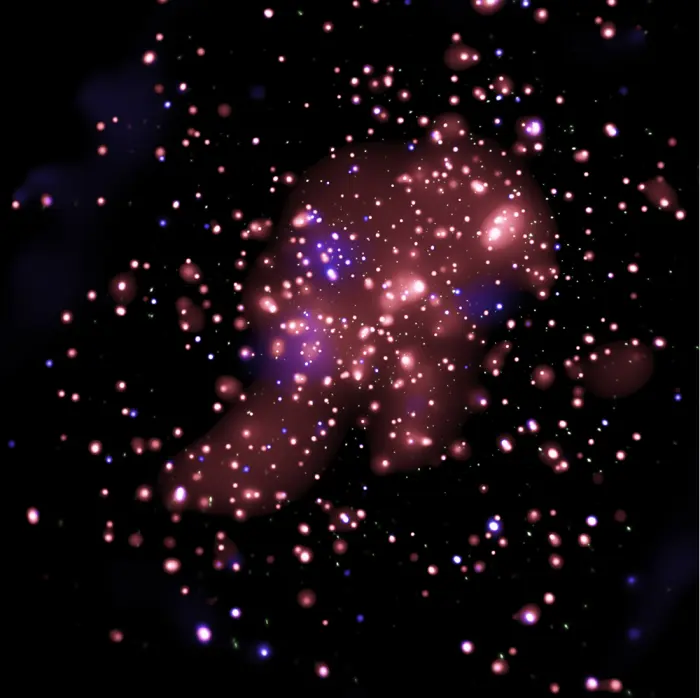
The Northern Jewel Box captured by the Chandra X-ray Observatory, image credit – X-ray: NASA/CXC/Univ. of Valparaiso/M. Kuhn et al; IR: NASA/JPL/WISE (PD)